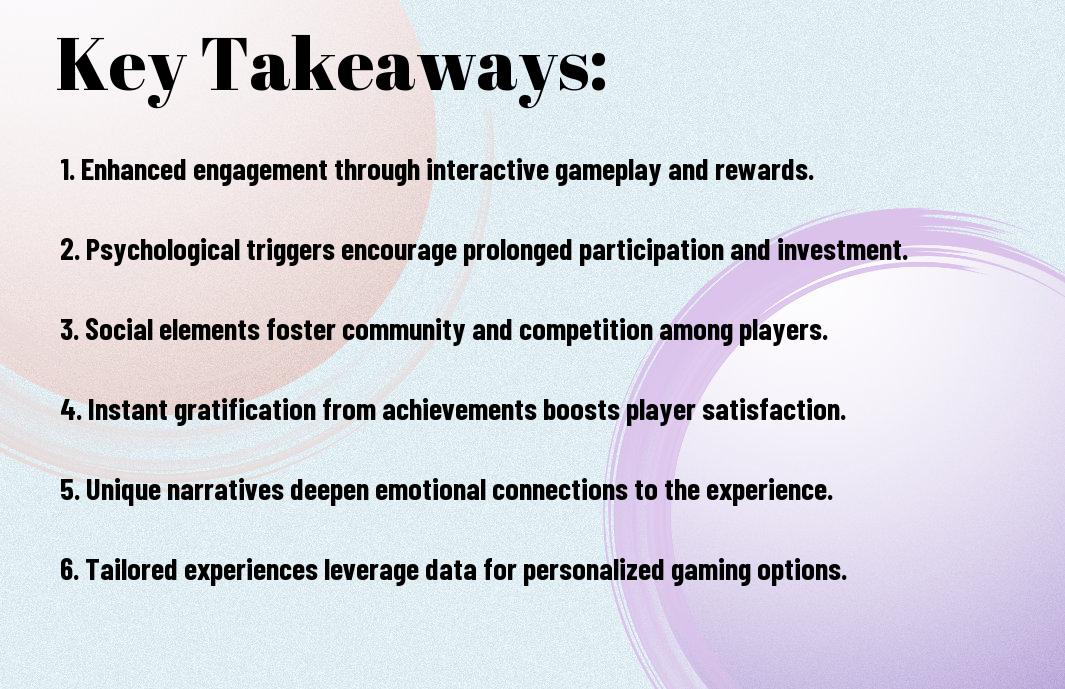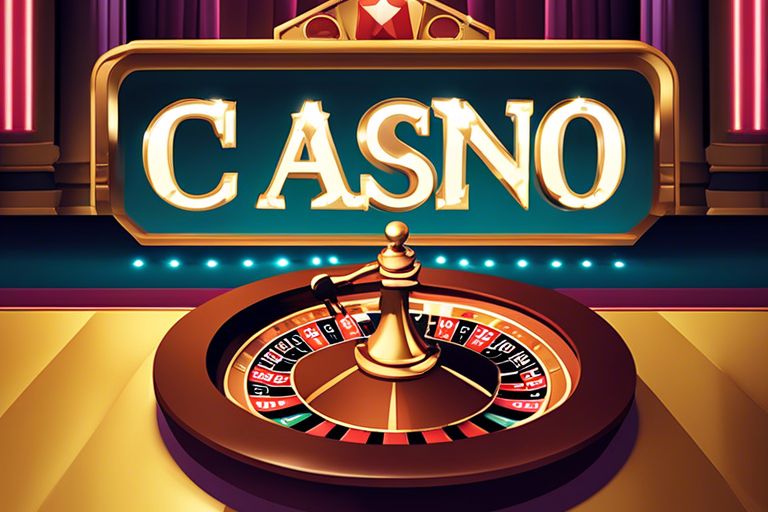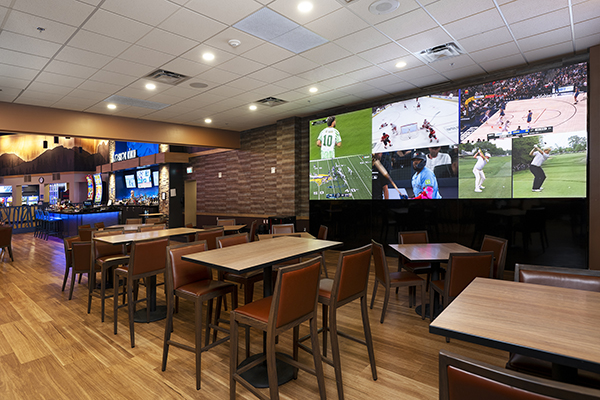Allure surrounds the world of gamified casino experiences, captivating players with interactive features and rewards that elevate traditional gaming. I find it fascinating how these elements not only enhance player engagement but also introduce a risk of addiction. You might be surprised to discover that gamified mechanics, such as progression systems and social interaction, drive your desire to play longer and spend more. Understanding these secrets can help you navigate this thrilling landscape while being aware of its potential pitfalls and benefits.
Key Takeaways:
- Engagement: Gamified casino experiences enhance user engagement by integrating interactive challenges and rewards, keeping players entertained for longer periods.
- Rewards System: The use of a dynamic rewards system taps into psychological triggers, encouraging players to continue playing to unlock bonuses and achievements.
- Social Interaction: Many gamified casinos incorporate social elements, allowing players to connect, compete, and share their successes, fostering a sense of community.
- Enhanced Experience: By incorporating storytelling and thematic elements, gamified experiences provide a more immersive gameplay experience, appealing to players’ emotions.
- Accessibility: Gamification lowers barriers to entry, making casino gaming more accessible and appealing to a wider audience, including those who may not typically engage with traditional casino environments.

Understanding Gamification
Before I investigate into the compelling world of gamified casino experiences, it’s crucial to establish a firm understanding of gamification. This term, while buzzing in technological and marketing circles, often eludes a concise definition. At its core, gamification involves the application of game-design elements and principles in non-game contexts to enhance user engagement, motivation, and participation. It leverages the innate human affinity for play, competition, and achievement, transforming mundane tasks into exciting experiences through elements like points, badges, leaderboards, and challenges. In doing so, gamification taps into our desire for accomplishment and recognition, turning ordinary interactions into journeys of both personal and collective growth.
One might wonder why this concept has gained such momentum in areas like education, health, and, notably, casinos. By integrating gamification, businesses not only attract customers but also maintain their interest over time. In casinos, for example, gamified experiences may manifest through various loyalty programs that reward players for consistent participation. These programs could include tiered rewards that encourage users to continue engaging with the platform, rich storytelling to immerse them in gameplay, or even social features that connect them with fellow players. The result is an innovative framework that pushes you to explore further while feeling entertained and valued.
In essence, gamification is less about traditional game mechanics and more about creating an engaging environment that fosters user participation. It is about blending psychological motivators to enrich experiences across diverse contexts, including the thrilling realm of casinos. To truly grasp the essence of gamification, you can think of it as an alchemical process—a mixture of motivation, design, and interaction, all stirred together to yield an end product that is both exciting and rewarding.
Historical Context and Evolution
Evolution of gamification can be traced back to various periods and manifestations of human interaction with games and competition throughout history. The roots of gamification stretch back to the dawn of civilization, where the elements of competition and reward were key in society’s development. From the ancient board games played in Mesopotamia to the competitive spirit of sports in ancient Greece, the human attraction to games has historically revolved around a natural desire for competition, socialization, and achievement. As we transitioned into the digital age, these principles began to surface in newer formats, setting the stage for modern gamification.
With the rise of technology, particularly the internet, gamification began to evolve significantly in the early 2000s. Platforms like social media started to resemble games, where users could earn virtual rewards like points or badges for their participation. This trend accelerated with the development of mobile technology, which made it easier than ever to engage users in premium gamified experiences. As casinos observed these shifts, they too sought to embrace this powerful tool, incorporating interactive elements into their gaming systems, casino apps, and loyalty programs to attract and retain users, thus redefining the traditional gambling paradigm.
Definition aside, the evolution continues even today as new technologies and theories emerge. Many online casinos are continuously innovating, leveraging data analytics and AI to create customized experiences that adapt to players’ preferences and behaviors. This ensures that the gambling environment remains engaging and caters to individual player attributes, further solidifying the importance of gamification in creating alluring casino experiences designed to captivate you from the moment you arrive.
Core Elements of Gamified Experiences
An understanding of the core elements of gamified experiences is necessary to grasp how they function effectively. At the heart of gamification lies a set of design features that encourage user interaction. First and foremost is the incorporation of progress tracking through points, experience levels, or other metrics that let you visualize your achievements. This visibility fuels your motivation, pushing you to reach the next milestone. Additionally, leaderboards create a sense of competition, allowing you to compare your performance with others while encouraging a social dynamic that holds great appeal. Finally, rewards systems—be it through tangible prizes or virtual accolades—serve to reinforce your bond with the platform, creating an ongoing cycle of engagement and gratification.
As you investigate deeper into gamified experiences, I find it necessary to highlight the importance of storytelling. An engaging narrative can elevate your experience, transforming tasks into quests or challenges that resonate on a personal level. When you are immersed in a story, the actions you take feel more significant and purposeful, thereby enhancing the overall engagement. This synergistic effect between gameplay, rewards, and narrative creates a holistic experience that captivates players and keeps them coming back.
This intricate web of elements lays the foundation for an environment where I can explore, compete, and be rewarded simultaneously. Variables such as instant feedback, social interaction, and opportunities for skill progression are necessary to the immersive experience. Gamification not only transforms how I engage with casinos but also enriches the overall experience, making each visit an adventure worth commenceing upon.
Psychological Factors Influencing Gamification
If you’re plunging into the fascinating world of gamified casino experiences, you’ll soon discover that psychological factors play a significant role in shaping these engaging environments. Understanding these elements can help you grasp why players are drawn to gamified experiences in the first place. Here are some key psychological factors that influence the allure of these interactive setups:
- Motivation
- Instant Gratification
- Risk and Reward
The Role of Motivation in Gaming
Psychological underpinnings of motivation are at the heart of why players are engrossed in gamified casino experiences. I’ve observed that motivation can be divided into intrinsic and extrinsic types. Intrinsic motivation revolves around personal satisfaction and the pleasure derived from the activity itself. For instance, players may find enjoyment in the challenge of mastering a particular game or savoring the feeling of accomplishment when completing a level. Conversely, extrinsic motivation usually involves external rewards—like cash bonuses, loyalty points, or prizes—that incentivize players to engage more deeply with the platform. Understanding this duality can help operators tailor their offerings to meet players’ diverse needs.
Your motivation is influenced by goal-setting and feedback mechanisms. Many gamified experiences incorporate elements that allow you to set achievable goals, whether that’s reaching a certain level, accumulating a specific number of points, or hitting a jackpot. When you accomplish these goals, immediate feedback lines up with your efforts, reinforcing your gameplay and making you feel successful. This positive reinforcement loop not only keeps you engaged but also encourages continuous participation in the experience. The platforms that effectively harness these motivational strategies are often the ones that stand out in your memorable gaming experiences.
The culmination of intrinsic and extrinsic motivations leads to greater player retention. Each time you return for another round of gameplay, it’s often a cycle of fulfillment that drives your engagement further. This cycle reflects a well-orchestrated game design that fosters a sense of achievement, community, and competition. The interplay of these motivational factors ultimately makes gamified casino experiences not just a game, but an emotional journey that keeps you coming back for more.
Instant Gratification and Reward Systems
Motivation is closely tied to the concepts of instant gratification and reward systems in gaming. I’ve noticed that the human brain is wired to seek pleasure and immediate rewards, an instinct that plays out distinctly in gamified casinos. When you hit a winning streak or level up, the rush of excitement floods your system, creating a powerful connection to the experience itself. This immediate feedback often acts as a catalyst that encourages continued engagement as you chase that next high.
This instant gratification serves not just to satisfy your immediate desires, but also creates a habit-forming cycle that further integrates you into the gaming experience. Platforms leverage this psychological trait by structuring their reward systems in a way that continuously feeds your need for instant rewards. Players often find themselves engaging over and over again for that dopamine hit — whether from a small win or the promise of a bigger payout. By refining the balance between visible rewards and the overall challenge associated with the games, operators can keep you hooked, all the while making you feel as though you are always one step away from a significant gain.
Role of reward systems in gamification enhances your overall experience. These carefully engineered systems capitalize on your need for feedback and satisfaction, reinforcing your behaviors and driving continued play. The effective use of immediacy in rewards creates an addictive nature, making it challenging for you to step away once the cycle is initiated.
The Psychology of Risk and Reward
Role of risk and reward psychology is another crucial element that adds to the allure of gamified casino experiences. I find it intriguing how the theoretical underpinnings of this concept dictate your willingness to engage in gameplay. You are often confronted with a spectrum of risk when gambling, where your decisions can lead to significant losses or substantial rewards. This balancing act triggers a psychological response that can be thoroughly thrilling. Embracing risk creates an emotional payoff, whether it manifests as intense excitement when placing a bet or the adrenaline rush you experience when waiting for the outcome.
This concept can be further explored through the notion of the “gambler’s fallacy,” where players often mistakenly believe that future outcomes will change based on past results. I’ve seen this fallibility in myself and others—where you might think that a particular slot machine is due for a win after a losing streak, which can amplify your attraction to the game despite the overarching odds. The anticipation and psychological tug-of-war between impending risk and desired reward can lead to compulsive behavior in some players, making it a noteworthy aspect of gamified experiences.
Role of risk-reward dynamics can foster a deeply engaging game environment that’s hard to walk away from. These psychological mechanisms work in tandem with your emotional instincts, leading to layers of engagement that can be both exhilarating and perilous. Understanding this interplay is critical, as it ultimately shapes your gambling experiences.
Understanding the intricacies of risk and reward will reveal how influential both psychological factors and personal motivations can be. It’s fascinating how our innate desires for thrill and financial gain shape our choices and outcomes in gamified casino settings. The more I investigate into these elements, the clearer it becomes how these influences can create an addictive yet pleasurable gaming atmosphere.
Technology’s Impact on Casino Gamification
Now, as we investigate deeper into the role of technology in enhancing casino gamification, it’s evident that innovative approaches such as Virtual Reality (VR) and Augmented Reality (AR) are transforming the gaming landscape. These immersive technologies allow players to step into a virtual casino environment where they can engage with games in a way that feels incredibly real. To me, one of the most exciting aspects of VR and AR applications is how they break down the barriers between physical and digital gaming. Imagine wearing a VR headset and finding yourself in a lavish casino surrounded by other players, experiencing the thrill of betting without leaving your home. This not only enhances the level of immersion but also replicates the vibrant social atmosphere found in traditional casinos.
To fully appreciate the impact of these technologies, it’s important to consider how they can breathe new life into classic casino games. For example, with AR, elements of the real world can be infused with interactive game features. I envision a scenario where players can use their smartphones to see virtual slot machines appear in their living room, complete with 3D animations that make winning feel more tangible. This blending of realities provides a novelty that regularly draws players back for more, ultimately contributing to increased engagement and loyalty. Moreover, these applications can offer players unique features such as customizable avatars and lucrative rewards that enhance both the gameplay experience and the social aspect of gaming.
To address potential concerns, it’s imperative to note that as thrilling as these technologies are, they also come with challenges. The implementation of VR and AR in casinos demands significant investments in hardware and software development, which may not always be feasible for smaller establishments. Furthermore, there are usability considerations, as players may require time to adjust to new interfaces and experiences. Nonetheless, I believe that as these technologies evolve and become more mainstream, they will redefine how we perceive and enjoy gambling, making the attractions of a casino more accessible to a wider audience.
Mobile Platforms and Accessibility
An integral part of the gamification revolution in casinos is the rise of mobile platforms. In today’s fast-paced world, players are constantly on the move, and having the ability to access their favorite games at their fingertips is a significant draw. I find that mobile applications offer unparalleled convenience, allowing you to engage in casino games anytime and anywhere. The seamless interface of mobile apps makes it easy to traverse between different games, and the gamified elements like rewards, leaderboards, and challenges makes the experience even more engaging. This constant access not only enhances your overall gaming experience but also fosters a deeper connection to the casino brand.
Additionally, as I explore this trend further, it’s clear that mobile platforms cater to a diverse audience. With the proper integration of gamification mechanics, these applications can appeal to younger generations who are used to interacting with technology. Furthermore, I’ve noticed that those who might have previously felt intimidated by the notion of physical casinos may find a safe space in mobile gaming, where they can familiarize themselves with the games at their own pace. This accessibility ultimately encourages a broader demographic to participate in the casino experience, thereby increasing player engagement.
Plus, it is worth mentioning that mobile platforms often leverage great connectivity features to enhance the player experience further. With cloud gaming technology, casinos can stream games directly to your mobile device without the need for high-end specifications. This inclusion means you don’t have to worry about device limitations, making high-quality gaming more accessible. As a player, you can also reap the benefits of in-app promotions and bonuses specifically designed to enhance the mobile experience, which is incredibly appealing for both newcomers and seasoned players alike.
Data Analytics and Personalization
Applications of data analytics in casino gamification are truly revolutionizing the gaming experience by allowing casinos to tailor offerings directly to individual preferences. From my perspective, the use of big data enables casinos to understand player behaviors thoroughly—what games you play, how frequently you visit, and even the type of rewards you respond to best. By utilizing this data, casino operators can create a personalized gaming journey for you, making the experience unique and engaging. This heightened sense of personalization can significantly increase player loyalty and satisfaction, showing that your needs and preferences are taken seriously.
Furthermore, the implications of data analytics extend beyond just personalization. I’ve observed that casinos can adjust promotions and bonuses based on real-time data, optimizing their marketing strategies to better resonate with their audience. For instance, if a specific game is underperforming, they can introduce gamified challenges or seasonal themes to revive interest. This dynamism not only elevates the gaming experience but also maximizes revenue potential for the casino. As you engage with these personalized experiences, you become more invested in your interactions, transforming your approach to gaming and gambling.
Augmented reality also enables casinos to gather insights into player engagement patterns. By analyzing what features attract your attention, they can make informed decisions regarding future game developments or enhancements. This continuous feedback loop allows for an iterative process of improvement, meaning every experience can be more tailored than the last. So, as you immerse yourself in these enhanced gaming environments, it’s clear that your preferences play a pivotal role in shaping the direction of casino offerings.
The Allure of Gamified Casino Experiences
Despite the inherent risks associated with gambling, I find myself captivated by the dynamic nature of gamified casino experiences. These environments are designed to engage players through well-thought-out game mechanics that not only entertain but also keep you coming back for more. For instance, features such as reward systems, progress tracking, and interactive challenges all play a pivotal role in increasing player engagement. The psychological concept of variable rewards—akin to that of a slot machine—fuels the excitement by creating anticipation and dopamine release, making losing a spin feel more bearable. I am often amazed at how these dynamics can transform what might otherwise be a solitary experience into an enthralling adventure filled with surprises.
Moreover, gamification in casinos employs social dynamics that encourage collaboration among players. Elements such as tournaments, team challenges, and leaderboards turn each session into a more communal affair. You may find yourself cheering for a fellow player or strategizing together, which can foster a sense of camaraderie that elevates the overall experience. The introduction of collaborative tasks can spark conversations and interactions, generating a vibrant atmosphere that you simply cannot find in traditional casinos. When your luck isn’t running, having someone to share your experiences with can make all the difference, adding layers of enjoyment beyond the gaming itself.
Additionally, I can’t overlook the impact that visual and audio elements have on enhancing gameplay. The engaging graphics and sound effects created via gamified elements brilliantly capture my attention, transforming conventional gambling tactics into a more immersive environment. This aesthetic richness often keeps me glued to the game for hours, as every sound—a slot machine’s whistle, a dealer’s call—serves as a cue for an exhilarating moment that heightens my experience. Consequently, the seamless integration of game mechanics with stimulating visuals and auditory signals paves the way for an unforgettable gaming journey.
Social Interaction and Community Building
Game mechanics play a vital role in gamified casino experiences, not just as isolated actions but as catalysts for social interaction. The state of play magnifies the gaming experience, allowing you to revel in jubilant victories or bond over shared misfortunes. I have personally found that the presence of leaderboards or communal challenges helps create an exhilarating and competitive environment where players can connect. You may discover that it is not just about the individual gameplay, but about sharing your achievements with others, discussing strategies, and even forming friendships in a lively gaming community.
With these engaging elements in play, I often discover a sense of belonging while participating in communal games. The energy within a group dynamic, whether on the casino floor or in an online platform, can amplify your enjoyment and commitment to the game. Gamified systems often include chat features or in-game emotes, enhancing communication and enabling a deeper connection among players. This interactive aspect fosters a community where you feel valued and recognized for your contributions, regardless of your gaming skill level.
Additionally, the social aspect extends to the collaborative duties that players can engage in. Many gamified experiences offer cooperative missions or challenges that require teamwork to achieve goals, fostering collaboration. This shared responsibility not only strengthens bonds among players but also encourages them to invest in each other’s success, creating a nurturing environment that enriches the overall gaming experience.
The Role of Narratives in Enhancing Engagement
To leverage the allure of gamified casino experiences, I have come to appreciate the complexities that narratives bring to the table. Game developers often embed rich stories that not only contextualize the gameplay but also add layers of meaning to your actions. A well-developed narrative can turn a simple slot machine spin into a quest, making every bet feel like a step toward fulfilling a greater purpose. I find myself more invested when there’s a story unfolding; it invites me to dive deeper into the universe of the game, encouraging an emotional connection that can be hard to shake off.
These narratives often interweave elements of conflict—such as thwarting a villain or launching on a treasure hunt—which can make the gaming journey all the more thrilling. As you navigate through challenges, the potential for personal growth or triumph over adversity adds layers of richness to the gameplay experience. It’s not just about winning or losing; it’s about the journey and the stories we share along the way. Narratives help to underscore the impact of each choice you make, intensifying the feeling of agency and ownership over the outcome of your experiences.
Enhancing the overall engagement, these narratives serve not only to excite but also to unify. As I engage with others in the gaming community, conversations frequently revolve around shared quests and experiences, fostering connections that run deeper than mere gaming statistics. The narrative arcs we collectively experience become central talking points that bond us, giving us shared moments to reminisce about long after the game has ended.

Comparison with Traditional Casino Experiences
To understand the differences between gamified casino experiences and traditional ones, it’s vital to recognize how each model operates and interacts with players. By closely examining their features and engagement tactics, we can uncover what makes gamified experiences particularly captivating.
| Traditional Casino Experiences | Gamified Casino Experiences |
|---|---|
| Primarily focus on the games themselves, such as slots, poker, or table games. | Integrate game mechanics such as scoring, levels, and achievements to enhance player engagement. |
| Player rewards are often limited to cash and comp points. | Rewards can include in-game currency, virtual items, and unique experiences. |
| Atmosphere is centered around gaming floors with minimal interaction. | Encourages community building through multiplayer setups and social features. |
Differences in Player Engagement Strategies
Any discussion about gamified versus traditional casino experiences must highlight the distinct differences in how they engage players. Traditional casinos often prioritize the games themselves, relying on the inherent excitement of gambling to draw players in. The atmosphere is thick with the sounds of spinning reels and chips being shuffled, creating a palpable energy that players feel when they enter. However, this approach can be somewhat limited in scope, merely relying on the thrill of the game to keep players coming back for more.
In contrast, gamified experiences employ a variety of interactive elements and game mechanics that create a more immersive and dynamic environment. By introducing systems such as challenges, leaderboards, and personalized avatars, these casinos tap into our basic instincts for competition and achievement. Players are more than just participants; they evolve into active seekers of progression and reward, pioneering a deeper connection with the gaming platform.
The use of social components in gamified casinos further differentiates them from traditional venues. Players can join teams or communities, fostering camaraderie that traditional casinos fail to achieve. This community-driven aspect not only enhances engagement but also facilitates shared experiences that make gameplay more memorable. Overall, these innovative methods stand in stark contrast to the solitary nature of traditional casino gaming.
Financial Implications for Casinos
Comparison of gamified and traditional casino models cannot exclude the financial dynamics involved. Gamified casinos generally attract a broader audience, including younger demographics who may feel more connected to gaming platforms than traditional casinos. By appealing to these groups through engaging mechanics, it often leads to increased player spending and, subsequently, higher revenues. Furthermore, these casinos can capitalize on microtransactions and in-game purchases, generating an additional revenue stream that traditional casinos typically lack.
This shift in financial strategy has implications for both operational costs and profit margins. Traditional casinos face substantial overheads related to physical space, staffing, and maintenance. In stark contrast, gamified experiences often leverage digital infrastructure, reducing these costs significantly. As a result, these operations can offer promotions with a lower cost base while still maximizing player engagement, positioning themselves favorably within a competitive market.
As I examine deeper into the financial implications, it becomes clear that gamified casinos not only adapt to changing player preferences but also create a more sustainable business model. By embracing innovative technology and marketing strategies, these gaming platforms can harness the power of data analytics to personalize experiences and deliver targeted promotions, driving further engagement and profitability.
Player Retention and Loyalty Programs
Casino operators have long recognized that player retention and loyalty are key components to sustained success. Traditional casinos often utilize comp points, loyalty cards, and tiered rewards systems, hoping to incentivize players to return. While these methods can be effective, they may not sufficiently address the evolving desires of modern gamblers. Here, gamified experiences reshape the landscape by offering more engaging and personalized loyalty programs that resonate with today’s gamers.
In gamified environments, loyalty programs become dynamic, driven by player achievements and interactions rather than just monetary loss or gain. When players complete in-game tasks or achieve certain levels, they unlock rewards that enhance their gameplay experience, such as exclusive content or limited-time events. This approach encourages deeper investment in the platform, resulting in not just repeat visits but also a stronger emotional connection to the brand.
Another significant benefit of gamified loyalty programs is their ability to enhance social engagement among players. Players can share achievements, compete with friends, and participate in group activities, leading to a more connected community. This social interaction plays a crucial role in fostering loyalty, as players derive enjoyment from sharing experiences with others. In this way, gamified loyalty programs are designed to create a sense of belonging while keeping players engaged.
Another aspect worth noting is how the reciprocal nature of these loyalty programs can foster a sense of achievement that contributes to overall player satisfaction. Players don’t just feel rewarded in the traditional sense; they develop a journey within the platform, making every step of the process feel significant. This focus on achievement over mere participation enhances the player experience and encourages long-term commitment to the casino.
Regulatory and Ethical Considerations
Once again, as I explore into the complex world of gamified casino experiences, it is crucial to acknowledge the regulatory and ethical considerations that guide these platforms. The integration of game mechanics into traditional gambling raises important questions about accountability, player protection, and the overall impact on society.
Responsible Gaming Practices
The responsible gaming practices surrounding gamified casinos are of paramount importance, as I believe it forms the backbone of any sustainable gambling environment. These practices ensure that players can enjoy their experience without crossing the line into harmful behaviors. It’s vital for you, as a player, to be aware of the potential risks involved and to engage with platforms that prioritize your well-being. Many of these casinos implement features that allow you to set limits on your spending and playing time, effectively giving you the control you need over your gambling habits.
Furthermore, I have observed that leading gaming operators have begun to incorporate player education and awareness programs within their platforms. These initiatives not only educate you about the risks associated with gambling but also highlight healthy gaming behaviors. It’s refreshing to see industry leaders embrace their social responsibility, allowing you to keep your gaming experience both entertaining and safe. The key is to utilize these resources and remain vigilant about your gameplay.
Finally, imposing strict measures on advertising and promotions is also an vital aspect of responsible gaming practices. In a world where the allure of gamified experiences can overshadow the potential dangers, it is imperative that you are not bombarded with misleading information that romanticizes gambling. Regulatory bodies increasingly mandate transparency in advertisements, ensuring consumers like you have a clear understanding of what is at stake when engaging with these platforms.
Regulation of Game Mechanics
An vital layer in this discussion is the regulation of game mechanics employed by gamified casinos. I find that these regulations serve to protect you, the consumer, by ensuring that the games are fair, transparent, and not deceptively designed to exploit psychological vulnerabilities. Regulations vary significantly by jurisdiction but generally require that game outcomes are determined by reliable random number generators (RNGs) and that you have a clear understanding of the odds associated with each game.
Moreover, as technology advances, the regulatory landscape for game mechanics must evolve. I believe it’s vital for authorities to continuously monitor these innovations to prevent exploitative practices, such as games designed to keep you engaged through predatory tactics. This might mean a closer examination of reward systems, leaderboards, and other gamification elements to ensure they do not cross the line into manipulation or addiction.
Gaming operators must also undergo regular audits to confirm compliance with these regulations, ensuring that you can trust the integrity of the games you’re playing. By scrutinizing these aspects, regulators can maintain a fair gambling ecosystem that benefits both the players and the operators, preserving the integrity of gaming as a whole.
Addressing Problem Gambling in a Gamified Context
For those of us exploring the implications of gamified casino experiences, tackling the issue of problem gambling within this context is imperative. The immersive nature of gamification can intensify the thrill of gaming, potentially leading to risky behaviors. Although gamification can enhance user experience, it also necessitates a strong focus on measures that can effectively address and mitigate the risk of addiction.
I have come to appreciate that many gamified casinos are now investing in tools and technologies that identify at-risk players by analyzing gameplay patterns. By employing sophisticated algorithms and data analytics, these platforms can proactively reach out to individuals exhibiting signs of problem gambling. This targeted approach is not only ethical but also an vital aspect of promoting healthy gaming behaviors among users.
As we navigate this evolving landscape, it’s vital to recognize that innovation in the gaming sector can be harnessed for positive outcomes. I firmly believe that the combination of cutting-edge technology and social responsibility can lead to significant advancements in prevention and intervention strategies, equipping you with the tools needed to enjoy gaming responsibly.
Game developers and operators are responsible for creating environments that are conducive to positive experiences without compromising your safety. By investing in the development of features such as self-exclusion options, loss limits, and real-time alerts on gameplay duration, operators demonstrate a commitment to addressing problem gambling in a gamified context. Ultimately, ensuring a balance between engagement and responsible gaming will be key in fostering a sustainable and ethical gaming experience.
Future Trends in Gamification within Casinos
Not many of us can predict where the future of gamification in casinos is headed, but certain trends and innovations are already peeking over the horizon. Innovations on the horizon refer to exciting developments that we can expect to see in the coming years as casinos look to enhance the gamified experience for their customers. This could include the incorporation of more immersive technologies like virtual reality (VR) and augmented reality (AR), allowing players to engage with casino games in ways that feel more real than ever. Imagine stepping into a virtual casino floor, where you can roam freely and interact with others, all from the comfort of your home. This shift could transform how we perceive gambling, moving it from a traditional, static experience to a dynamic, interactive event that draws you into a vibrant world.
There’s also the potential for mobile gamification to take a significant leap forward. With smartphones becoming an integral part of our daily lives, I anticipate casino apps will offer increasingly sophisticated features that entice players to engage more frequently. This may involve unique rewards systems tailored to individual preferences, where the more you play, the more exclusive benefits or personalized experiences you earn. Players may find themselves unlocking special events, in-game items, or even sponsored tournaments, making the gamification facet of casinos even more attractive and engaging.
As the tech ecosystem surrounding casinos evolves, so will the myriad of choices available to players. We will likely see greater integration of social gaming elements, where you can not only play against friends but also share achievements, play challenges, or engage in team-based experiences. This could redefine not just how you gamble, but how you socialize, creating a community around the gaming experience. The allure of shared in-game accomplishments can lead to greater retention and loyalty among players, making them feel part of something larger while also delighting in their individual journey.
The Evolving Role of AI in Gaming Experiences
Future technologies such as artificial intelligence (AI) will play an increasingly pivotal role in shaping personalized gaming experiences. I envision a gaming landscape where AI algorithms analyze your past behaviors and preferences to customize game suggestions, promotions, and even interactions based on what you are most likely to enjoy. This level of personalization could significantly alter how you engage with casino content and help create unique experiences that resonate more with your individual gaming style. By learning from your habits, AI can enhance the thrill of discovery, showing you new games that align with your interests and pushing you to explore various avenues of gamification, effectively keeping boredom at bay.
A further dimension where AI can enhance the gaming experience is through responsible gambling initiatives. I believe that leveraging AI offers casinos the opportunity to monitor player behavior patterns in real-time, identifying signs of problematic gambling early. If you were to spend an unusually long time making bets or consistently lose more than you are comfortable with, AI-powered systems could trigger alerts, encouraging you to take a break or seek help if necessary. This added layer of proactive care shows a commitment not only to fun and engagement but also to the well-being of players, fostering a more responsible gaming environment.
Predictions for the Future of Gamified Casinos
Innovations in technologies and methodologies are continuously reshaping the casino landscape, and I believe that the next decade will usher in a revolutionary wave of gamified experiences. There will be an even more pronounced integration between physical and digital realms, allowing you to move seamlessly between experiences. Imagine a scenario where you can start your gambling journey in a physical casino and continue it right where you left off on a mobile app or through a virtual reality headset. This convergence will likely lead to greater player engagement and loyalty, with casinos designing tailored experiences based on where you typically participate, either online or offline.
Moreover, sustainability will emerge as a crucial focus within the gamification space. As environmental awareness continues to grow, you can expect casinos to evolve by incorporating aspects that resonate with eco-conscious players. This could mean gamified rewards systems that encourage environmentally responsible behavior or even virtual games that highlight sustainability through their themes and mechanics. Casinos that embrace and market this approach will not only appeal to a broader audience but also strengthen their brand identity as forward-thinking entities.
For instance, one prediction is that we will see further consolidation and collaboration between the hotel and gaming sectors. You might find enticing gamified packages that blend casino experience with hotel bookings, loyalty points, and exclusive experiences that elevate your stay. These collaborations could delight you with unique theme nights, bundled entertainment packages, and in-room technology that allows you to engage with the casino while unwinding in your accommodations. As these innovations arise, the future of gamified casinos appears to promise enhancements that will redefine not just how we gamble but how we socialize and experience the thrill of gaming.
Summing up
Presently, I find myself reflecting on the intricate layers that contribute to the allure of gamified casino experiences. As a participant in this fascinating domain, I realize that the gamification elements employed in these settings serve not merely as entertainment but as psychological tools that enhance engagement and retention. By integrating game-like mechanisms such as rewards, challenges, and leaderboards, casinos effectively create an environment that keeps you coming back for more. Your innate human desire for achievement, competition, and social interaction is skillfully tapped into, making every visit feel like an opportunity for a thrilling adventure rather than a straightforward gamble. Consequently, I believe that understanding these gamified features can empower you to navigate your gaming experience more wisely, ensuring that enjoyment remains paramount without becoming ensnared in the addictive traps they can lay.
Moreover, it is important to acknowledge the technology that enhances these experiences. Advanced algorithms, immersive graphics, and personalized experiences are just the tip of the iceberg when it comes to the innovations driving gamification in the casino landscape. These technological advancements appeal to your senses, drawing you into an almost fantastical world where the line between gambling and gaming becomes increasingly blurred. When I play, the user interface engages me in a way that generates excitement, rewards keep the adrenaline flowing, and competitive elements motivate me to improve my gameplay. This convergence of technology and psychology is what I see as a significant factor behind the magnetic pull of gamified casinos, making it appear almost effortless to lure you into their compelling atmospheres.
Lastly, the secrets behind the allure of gamified casino experiences are multifaceted, touching upon psychological, social, and technological elements. While indulging in these captivating environments can be exhilarating, I encourage you to remain aware of the underlying mechanics at play. As you immerse yourself in these gamified experiences, it is necessary to maintain a balance, allowing yourself to enjoy the thrill without succumbing to its potential pitfalls. To fully embrace the excitement of casino gaming, I suggest fostering a mindful approach that celebrates the remarkable innovations while remaining attuned to your personal limits. Understanding these dynamics affords you the empowerment to truly relish your experience rather than merely being swept away by it. The allure, after all, is an intricate dance between engagement and discernment, a balance that can make your gaming experience not only enjoyable but also fulfilling.
FAQ
Q: What are gamified casino experiences?
A: Gamified casino experiences integrate game-like elements such as points, levels, and challenges into traditional gambling activities. This approach enhances the user experience by making it more interactive and engaging, encouraging players to participate longer and more frequently, while providing a sense of achievement and entertainment. Features can include rewards for certain actions, leaderboards, and progression mechanics.
Q: How do gamified elements enhance player engagement in casinos?
A: Gamified elements, such as rewards systems, competitions, and social interactions, significantly boost engagement levels. By incorporating achievement milestones and interactive challenges, players feel more invested in the gaming experience. These elements tap into psychological aspects of motivation, making players want to return for more rewards and levels, thus increasing their overall participation and enjoyment.
Q: What psychological factors contribute to the allure of gamified casino experiences?
A: Several psychological factors enhance the allure of gamified casino experiences, including the dopamine release from reward systems, the excitement of competition, and the natural human affinity for games. Gamification leverages the principles of operant conditioning where players receive instant gratification from wins and progress, making the gambling experience not just about chance, but also about skill and achievement, creating a deeper emotional investment.
Q: Are there potential drawbacks to gamified casino experiences?
A: While gamified casino experiences offer significant benefits, there are notable potential drawbacks, including the risk of increased gambling addiction due to heightened engagement. The compelling nature of these games can lead some players to lose track of time and money. Additionally, there may be concerns about ethical responsibility among casino operators to ensure they are not exploiting players’ psychological triggers for profit. Responsible gaming measures should be implemented to mitigate these risks.
Q: How do gamified casino experiences differ from traditional gambling methods?
A: Gamified casino experiences differ from traditional gambling methods primarily in their use of interactive and competitive features. While traditional gambling focuses on chance and luck, gamified experiences emphasize skill, strategy, and engagement. Players participate in a more dynamic environment with immediate feedback, rewards, and social components, transforming the solitary nature of conventional gambling into a more community-oriented and multifaceted entertainment experience.





